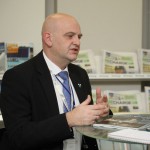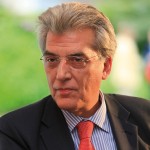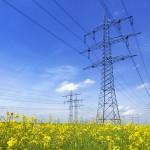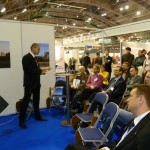 One of the biggest grids-related buzzes in the last couple of years has been the coming together of ten countries to promote an interconnected power network in the northern European seas. At the GRIDS 2010 event in Berlin I caught up with Jan Hensmans from Belgium’s Economy Ministry, who explained the ‘North Seas Countries Offshore Grid Initiative’ (NSCOGI) in more detail.
One of the biggest grids-related buzzes in the last couple of years has been the coming together of ten countries to promote an interconnected power network in the northern European seas. At the GRIDS 2010 event in Berlin I caught up with Jan Hensmans from Belgium’s Economy Ministry, who explained the ‘North Seas Countries Offshore Grid Initiative’ (NSCOGI) in more detail.
Why did Belgium decide to get involved in NSCOGI?
We saw the huge energy potential of the north seas and we had been involved in the ‘pentalateral energy forum’ with Germany, France, the Netherlands and Luxembourg, but five countries were not enough! So we set up a meeting with those and additional countries and the ministers signed a political statement on 7 December 2009. Then we organised a high level meeting in Ostend with EWEA – at which we agreed to sign a memorandum of understanding, which we will do on 3 December in Brussels.
 Promoting wind power and other renewables while dramatically expanding the grid system are now cornerstones of German energy policy, people attending the opening session at the Grids 2010 conference in Berlin were told today.
Promoting wind power and other renewables while dramatically expanding the grid system are now cornerstones of German energy policy, people attending the opening session at the Grids 2010 conference in Berlin were told today.
Jochen Homann, State Secretary, Federal Ministry of Economics and Technology for Germany, also told conference delegates that Europe badly needs new electricity highways to efficiently meet future energy needs.
“The need to act is most pressing,” Homann said, adding European citizens need to understand why policy makers now agree that it is vitally important to update the grid system despite considerable associated challenges and costs.
 Delegates attending the Grids 2010 conference in Berlin on Tuesday and Wednesday will be hearing how both the future of Europe and its need for a totally revamped electricity structure are indelibly linked.
Delegates attending the Grids 2010 conference in Berlin on Tuesday and Wednesday will be hearing how both the future of Europe and its need for a totally revamped electricity structure are indelibly linked.
They’ll also hear that while building a so-called supergrid for the 21st century will be expensive, the many benefits will far outweigh any costs associated with such an ambitious European project. And, in any event, our existing outdated grid requires very substantial investment.
And they’ll learn that having a properly functioning electricity market will help drive Europe’s goal of realising a new and robust green economy that can mitigate climate change, create tens of thousands of well-paying jobs and drive down power prices.

Imagine not being able to buy food or clothing from any country apart from your own. How boring – and expensive – our lives would be. Yet this is the case with most of our electricity. Because our power grids have few links between countries, 95% of power in Europe is consumed in the country in which it is produced.
An updated, Europe-wide power grid, with stronger, more numerous interconnectors, would allow wind power to be transported from wherever in Europe it’s blowing to wherever in Europe the consumers are, and open up cross-border trade in electricity.
Opening up the power market in Europe would have a far greater impact on thousands of consumers, bringing prices down as fuel-free wind power and other renewables would be preferred by the market to fossil fuels with unpredictable costs.
By guest blogger Elke Zander
 Finland is making huge steps to exploiting the power it has in the air, explained Anni Mikkonen, Executive Director of the Finnish Wind Power Association, at the Energia10 event in Tampere, Finland where EWEA brought its ‘Breath of fresh air’ campaign this week.
Finland is making huge steps to exploiting the power it has in the air, explained Anni Mikkonen, Executive Director of the Finnish Wind Power Association, at the Energia10 event in Tampere, Finland where EWEA brought its ‘Breath of fresh air’ campaign this week.
Two major obstacles to the development of wind energy have been addressed by the government and are currently in decision process with the Finnish parliament. Firstly, the lack of feed-in tariff to support wind energy. This is due to change from January 2011, the government says. The Finnish Wind Power Association is certain that with a feed-in tariff a major hurdle will be overcome, although Mikkonen stresses that the tariff levels are quite low, making near shore sites the most profitable in terms of wind energy.
Another issue has been spatial planning. Until now, two different plans had to be submitted: a local master plan and a local detailed plan. A new law has been designed now to only require the local master plan. This law proposal is with the parliament for decision as well.
 One of the biggest grids-related buzzes in the last couple of years has been the coming together of ten countries to promote an interconnected power network in the northern European seas. At the GRIDS 2010 event in Berlin I caught up with Jan Hensmans from Belgium’s Economy Ministry, who explained the ‘North Seas Countries Offshore Grid Initiative’ (NSCOGI) in more detail.
One of the biggest grids-related buzzes in the last couple of years has been the coming together of ten countries to promote an interconnected power network in the northern European seas. At the GRIDS 2010 event in Berlin I caught up with Jan Hensmans from Belgium’s Economy Ministry, who explained the ‘North Seas Countries Offshore Grid Initiative’ (NSCOGI) in more detail.






 Comments
Comments



